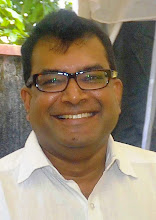I had a comment on my Facebook by
a friend who noted that as part of our political activities, wherever we go
there is some sort of religious connotation. He lives in America, and there is
STRICT separation of Church and State there, and there is NO religious
involvement in everyday politics. There are a few notable exceptions such as
the National Prayer Breakfast at which the President of the USA officiates, so
I can understand his dismay.
In Sri Lanka on the other hand we
received religious blessings no matter what religion we happen to practice,
usually the majority religion in the location we visit as a guest, we partake
in whatever function, like a prayer or pancha seela or whatever other religious
practice. On Sunday I was first at a temple and soon after at a Devale. There
were two different types of ceremony. We from time to time have to go to
Mosques to give chairs for a Muslim Daham Pasala or a Christian Church for a
function, and accordingly the local traditions of the area, namely of the
congregation gathered at the event is observed.
I would like to point out that
the Provincial Counselor at the event on Sunday, a Muslim, had a pirith noola
tied on his hand by the Chief Priest of the Temple. So in a multi religious
country, we must respect all religions and be flexible in how we handle
religious observances. The Cricket grounds the tournament that we participated
in on Sunday was next to a temple. Accordingly the Chief Priest of the Temple
was invited to the podium, and stayed throughout the tournament, in the most important
position in the order of preferences.
I personally do not find it a distraction,
as it is accepted as part of Sri Lankan custom even in politics. So there are a
few items we stand up for, namely any religious observance, then the singing of
the National Anthem, and the Party Song, and also to remember the Political Party
people who have sacrificed their lives in the interests of democracy. Further when
we observe a moment of silence for those who died in the Insurgency, we also stand
and observe a minutes silence.
I write this to give my readers, and
some of my friends who now see numerous photos of my with many people I meet in
my daily activities in Facebook, and see me with different religious clergy at different
functions. One must also remember that many religious places of worship also double
as community halls in villages, and therefore it is intertwined with the fabric
of village life.
Any observations by my readers in
this regard will be welcome.

